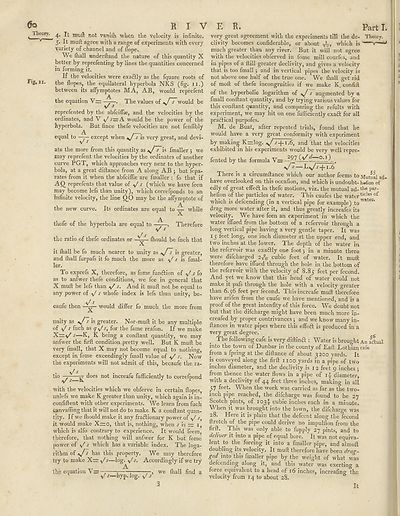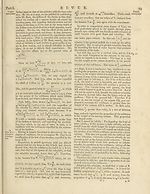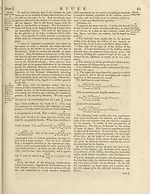Encyclopaedia Britannica, or, a Dictionary of arts, sciences, and miscellaneous literature : enlarged and improved. Illustrated with nearly six hundred engravings > Volume 18, RHI-SCR
(66) Page 60
Download files
Complete book:
Individual page:
Thumbnail gallery: Grid view | List view

Fig, ii.
R I V
4- It mu ft not vanlfti when the velocity is infinite.
5. It muft agree with a range of experiments with every
variety of channel and of Hope.
We fliall nnderftand the nature of this quantity X
better by reprefenting by lines the quantities concerned
in forming it.
If the velocities were exaftly as the fquare roots of
the Hopes, the equilateral hyperbola NKS (fig. 11.)
between its aflymptotes MA, AB, would reprefent
A
the equation V— ——. The values of * / j would be
reprefented by the abfciflse, and the velocities by the
ordinates, and V szzA would be the power of the
hyperbola. But fince thefe velocities are not fenfibly
equal to —except when is very great, and devi¬
ate the more from this quantity as s is fmaller ; we
may reprefent the velocities by the ordinates of another
curve PGT, which approaches very near to the hyper¬
bola, at a great diftance from A along AB ; but fepa-
rates from it when the abfciflae are fmaller : fo that if
A£) reprefents that value of v/J' (which we have feen
may become lefs than unity), which correfponds to an
infinite velocity, the line QO may be the aflymptote of
A
the new curve. Its ordinates are equal to — while
.X.
thofe of the hyperbola are equal to
•v/ s
A
Therefore
the ratio of thefe ordinates or
r *
fhould be fuch that
it ftiall be fo much nearer to unity as is greater,
and ihall furpafs it fo much the more as -y/ j is fmal¬
ler.
To exprefs X, therefore, as fome function of y/ r fo
as to anfwer thefe conditions, we fee in general that
X muft be lefs than y/ j-. And it muft; not be equal to
any power of y/ whofe index is lefs than unity, be-
y/ s
caufe then
X
would differ fo much the more from
unity as V s is greater. Nor muft; it be any multiple
of y/ s fuch as ^y/j-, for the fame reafon. If we make
x—y/ J-—K, K being a conftant quantity, we may
anfwer the firft condition pretty well. But K muft be
very fmall, that X may not become equal to nothing,
except in fome exceedingly fmall value of y/ s. Now
the experiments will not admit of this, becaufe the ra-
tio ^ ^ ^ does not increafe fufficiently to correfpond
with the velocities which we obferve in certain Hopes,
unlefs we make K greater than unity, which again is in-
eonfiftent with other experiments. We learn from fuch
canvafting that it will not do to make K a conftant quan¬
tity. If we ftiould make it any fraflionary power of y/ j1,
it would make X=o, that is, nothing, when is =r 1,
which is alfo contrary to experience. It would feem,
therefore, that nothing will anfwer for K but fome
power of y/ j which has a variable index. The loga¬
rithm of J- has this property. We may therefore
try to make X— y/s—log. y/ j-. Accordingly if we try
the equation V=i ; —, we (hall find a
y/j-—hyp, log. y/j-
E R. Part I.
very great agreement with the experiments till the de- Theory,
clivity becomes confiderable, or about which is v—^
much greater than any river. But it will not agree
with the velocities obferved in fome mill courfes, and
in pipes of a Hill greater declivity, and gives a velocity
that is too fmall j and in vertical pipes the velocity is
not above one half of the true one. We fhall get rid
of moft of thefe incongruities if we make K. confift
of the hyperbolic logarithm of y/ j- augmented by a
fmall conftant quantity, and by trying various values for
this conftant quantity, and comparing the refults with
experiment, we may hit on one fufficiently exaift for all
praftical purpofes.
M. de Buat, after repeated trials, found that he
would have a very great conformity with experiment
by making K=log. y/and that the velocities
exhibited in his experiments would be very well repre¬
fented by the formula V — ^.
'T W j* —1 .b
There is a circumftance which our author feems to Mumal ad-
have overlooked on this occafion, and which is undoubt- h*fion of
edly of great effeft in thefe motions, viz. the mutual ad-the Par-
hefion of the particles of water. This caufes the waterticles
which is defcending (in a vertical pipe for example) toWBteC"
drag more water after it, and thus greatly increafes its
velocity. We have feen an experiment in which the
water iffued from the bottom of a refervoir through a
long vertical pipe having a very gentle taper. It was
15 feet long, one inch diameter at the upper end, and
two inches at the lower. The depth of the water in
the refervoir was exadlly one foot j in a minute there
were difcharged 2T9o cubic feet of water. It muft
therefore have iffued through the hole in the bottom of
the refervoir with the velocity of 8.85 feet per fecond.
And yet we know that this head of water could not
make it pafs through the hole with a velocity greater
than 6.56 feet per fecond. This increafe muft "therefore
have arifen from the caufe we have mentioned, and is a
proof of the great intenfity of this force. We doubt not
but that the difcharge might have been much more in-
creafed by proper contrivances ; and we know many in-
ftances in water pipes where this effedl is produced in a
very great degree.
The following cafe is very diftin£l : Water is brought An adtual
into the town of Dunbar in the county of Eaft Lothian cafe
from a fpring at the diftance of about 3200 yards. It
is conveyed along the firft 1100 yards in a pipe of two
inches diameter, and the declivity is 1 2 feet 9 inches ;
from thence the water flows in a pipe of 14 diameter
with a declivity of 44 feet three inches, making in all
57 feet. When the work was carried as far as the two-
inch pipe reached, the difcharge was found to be 27
Scotch pints, of 1034 cubic inches each in a minute.
When it was brought into the town, the difcharge was
28. Here it is plain that the defcent along the fecond
ft retch of the pipe could derive no impulfion from the
firft. This was only able to fupply 27 pints, and to
deliver it into a pipe of equal bore. It was not equiva¬
lent to the forcing it into a fmaller pipe, and almoft
doubling its velocity. It muft therefore have been drctg-
ged into this fmaller pipe by the weight of what was
defcending along it, and this water was exerting a
force equivalent to a head of 16 inches, increaling the
velocity from 14 to about 28.
It
R I V
4- It mu ft not vanlfti when the velocity is infinite.
5. It muft agree with a range of experiments with every
variety of channel and of Hope.
We fliall nnderftand the nature of this quantity X
better by reprefenting by lines the quantities concerned
in forming it.
If the velocities were exaftly as the fquare roots of
the Hopes, the equilateral hyperbola NKS (fig. 11.)
between its aflymptotes MA, AB, would reprefent
A
the equation V— ——. The values of * / j would be
reprefented by the abfciflse, and the velocities by the
ordinates, and V szzA would be the power of the
hyperbola. But fince thefe velocities are not fenfibly
equal to —except when is very great, and devi¬
ate the more from this quantity as s is fmaller ; we
may reprefent the velocities by the ordinates of another
curve PGT, which approaches very near to the hyper¬
bola, at a great diftance from A along AB ; but fepa-
rates from it when the abfciflae are fmaller : fo that if
A£) reprefents that value of v/J' (which we have feen
may become lefs than unity), which correfponds to an
infinite velocity, the line QO may be the aflymptote of
A
the new curve. Its ordinates are equal to — while
.X.
thofe of the hyperbola are equal to
•v/ s
A
Therefore
the ratio of thefe ordinates or
r *
fhould be fuch that
it ftiall be fo much nearer to unity as is greater,
and ihall furpafs it fo much the more as -y/ j is fmal¬
ler.
To exprefs X, therefore, as fome function of y/ r fo
as to anfwer thefe conditions, we fee in general that
X muft be lefs than y/ j-. And it muft; not be equal to
any power of y/ whofe index is lefs than unity, be-
y/ s
caufe then
X
would differ fo much the more from
unity as V s is greater. Nor muft; it be any multiple
of y/ s fuch as ^y/j-, for the fame reafon. If we make
x—y/ J-—K, K being a conftant quantity, we may
anfwer the firft condition pretty well. But K muft be
very fmall, that X may not become equal to nothing,
except in fome exceedingly fmall value of y/ s. Now
the experiments will not admit of this, becaufe the ra-
tio ^ ^ ^ does not increafe fufficiently to correfpond
with the velocities which we obferve in certain Hopes,
unlefs we make K greater than unity, which again is in-
eonfiftent with other experiments. We learn from fuch
canvafting that it will not do to make K a conftant quan¬
tity. If we ftiould make it any fraflionary power of y/ j1,
it would make X=o, that is, nothing, when is =r 1,
which is alfo contrary to experience. It would feem,
therefore, that nothing will anfwer for K but fome
power of y/ j which has a variable index. The loga¬
rithm of J- has this property. We may therefore
try to make X— y/s—log. y/ j-. Accordingly if we try
the equation V=i ; —, we (hall find a
y/j-—hyp, log. y/j-
E R. Part I.
very great agreement with the experiments till the de- Theory,
clivity becomes confiderable, or about which is v—^
much greater than any river. But it will not agree
with the velocities obferved in fome mill courfes, and
in pipes of a Hill greater declivity, and gives a velocity
that is too fmall j and in vertical pipes the velocity is
not above one half of the true one. We fhall get rid
of moft of thefe incongruities if we make K. confift
of the hyperbolic logarithm of y/ j- augmented by a
fmall conftant quantity, and by trying various values for
this conftant quantity, and comparing the refults with
experiment, we may hit on one fufficiently exaift for all
praftical purpofes.
M. de Buat, after repeated trials, found that he
would have a very great conformity with experiment
by making K=log. y/and that the velocities
exhibited in his experiments would be very well repre¬
fented by the formula V — ^.
'T W j* —1 .b
There is a circumftance which our author feems to Mumal ad-
have overlooked on this occafion, and which is undoubt- h*fion of
edly of great effeft in thefe motions, viz. the mutual ad-the Par-
hefion of the particles of water. This caufes the waterticles
which is defcending (in a vertical pipe for example) toWBteC"
drag more water after it, and thus greatly increafes its
velocity. We have feen an experiment in which the
water iffued from the bottom of a refervoir through a
long vertical pipe having a very gentle taper. It was
15 feet long, one inch diameter at the upper end, and
two inches at the lower. The depth of the water in
the refervoir was exadlly one foot j in a minute there
were difcharged 2T9o cubic feet of water. It muft
therefore have iffued through the hole in the bottom of
the refervoir with the velocity of 8.85 feet per fecond.
And yet we know that this head of water could not
make it pafs through the hole with a velocity greater
than 6.56 feet per fecond. This increafe muft "therefore
have arifen from the caufe we have mentioned, and is a
proof of the great intenfity of this force. We doubt not
but that the difcharge might have been much more in-
creafed by proper contrivances ; and we know many in-
ftances in water pipes where this effedl is produced in a
very great degree.
The following cafe is very diftin£l : Water is brought An adtual
into the town of Dunbar in the county of Eaft Lothian cafe
from a fpring at the diftance of about 3200 yards. It
is conveyed along the firft 1100 yards in a pipe of two
inches diameter, and the declivity is 1 2 feet 9 inches ;
from thence the water flows in a pipe of 14 diameter
with a declivity of 44 feet three inches, making in all
57 feet. When the work was carried as far as the two-
inch pipe reached, the difcharge was found to be 27
Scotch pints, of 1034 cubic inches each in a minute.
When it was brought into the town, the difcharge was
28. Here it is plain that the defcent along the fecond
ft retch of the pipe could derive no impulfion from the
firft. This was only able to fupply 27 pints, and to
deliver it into a pipe of equal bore. It was not equiva¬
lent to the forcing it into a fmaller pipe, and almoft
doubling its velocity. It muft therefore have been drctg-
ged into this fmaller pipe by the weight of what was
defcending along it, and this water was exerting a
force equivalent to a head of 16 inches, increaling the
velocity from 14 to about 28.
It
Set display mode to:
![]() Universal Viewer |
Universal Viewer | ![]() Mirador |
Large image | Transcription
Mirador |
Large image | Transcription
Images and transcriptions on this page, including medium image downloads, may be used under the Creative Commons Attribution 4.0 International Licence unless otherwise stated. ![]()
| Permanent URL | https://digital.nls.uk/193019565 |
|---|
| Attribution and copyright: |
|
|---|
| Description | Ten editions of 'Encyclopaedia Britannica', issued from 1768-1903, in 231 volumes. Originally issued in 100 weekly parts (3 volumes) between 1768 and 1771 by publishers: Colin Macfarquhar and Andrew Bell (Edinburgh); editor: William Smellie: engraver: Andrew Bell. Expanded editions in the 19th century featured more volumes and contributions from leading experts in their fields. Managed and published in Edinburgh up to the 9th edition (25 volumes, from 1875-1889); the 10th edition (1902-1903) re-issued the 9th edition, with 11 supplementary volumes. |
|---|---|
| Additional NLS resources: |
|

